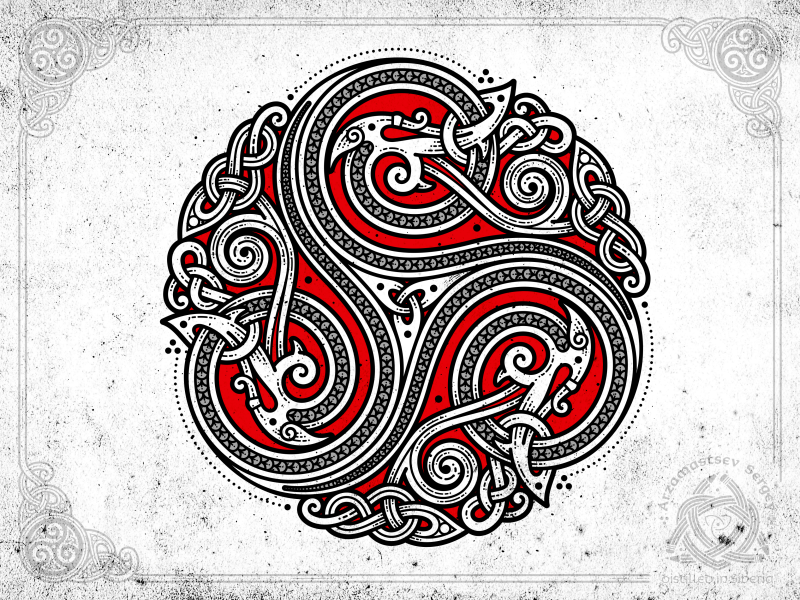Kháotic Casting
By the Blue Flames of Chol, the Heavens shall burn. By the Green Salts of Leviathan, the Oceans shall be parched. By the Red Tears of Behemoth, the Land shall bleed. In the names of the Triumvirate, let the glory of Kháos reign supreme. ~ The Caster's Oath
Introduction
Kháotic Casting is an archaic arcane art, whose practitioners utilize their parasitic bond with an Element of Chaos to access the dimensional prison of three primordial beings known as the "Kháotic Trinity" or "Triumvirate of Chaos" in order to draw upon the Chaotic Energies of these beings. Despite its overall concepts and general modes of operation being quite similar to the art of Fossilcraft, the two arts are generally regarded as the complete antithesis to each other, with the users of both techniques generally hating each other with a burning passion. While a large part of these hostilities are undoubtedly the result of numerous cultural and political conflicts between various rivaling factions that heavily utilize either Casting or Fossilcraft, there also appears to be a certain amount of natural friction between the two arts, as even users that come from the same ethnic and cultural background invariably disprize each other.Pieces of Sovereignty
The central components of Kháotic Casting are the so-called "Chaotic Fragments", which are semi-sentient lumps of Kháos-infused matter that slowly traverse the seas, skies, and lands of Cenorad in order to locate a worthy host organism. Once they managed to find a suitable candidate, they will attempt to force their way into the mouth of their chosen host, as Chaotic Fragments have to be ingested to unfold their function. Given that most Fragments are only able to exert a relatively small amount of force, most individuals are easily able to fend off these unwanted advances once they managed to overcome the initial surprise. Due to this, the number of involuntary Casters is significantly lower than the number of Casters that willingly ingested a Chaotic Fragment, which in the eyes of most Fossilcraft users makes them all the more condemnable. As one would expect from an arcane art centered around the Kháotic Trinity, there are exactly three different types of Chaotic Fragments, whose name and appearance corresponds to the Three Elements of Chaos and the mythical beings that rule over them.Feathers of Chol
Said to have once been part of the plumage of the Burning Peafowl, the so-called "Feathers of Chol" are chunks of perpetually burning sulfur, that commonly take on a quill or down-like appearance. While they are significantly heavier than any other type of mundane feathers, they are nevertheless able to gracefully glide through the air, which allows them to traverse large distances in a relatively short time when compared to the other types of Chaotic Fragments. Due to this, they are by far the most frequent and widely spread type of Fragment, which in turn means that Sulfur Casters can be encountered in nearly every part of Cenorad.Scales of Leviathan
Assumed to be remnants of the shed skin of the Salted Serpent, the "Scales of Leviathan" are colorful pieces of crystalized salt whose leaf-like appearance closely matches that of various types of snake scales. Despite being made entirely from salt, these scales are not only completely insoluble in water but are outright hydrophobic, which enables them to float on the water surface and thereby utilize various forms of water currents for long-distance travel. Because of this method of movement, this particular type of Fragment can usually only be encounter at the shores and coasts of large bodies of water, such as rivers and oceans, which in turn means that Salt Casters can usually only encounter in these regions.Tears of Behemoth
Supposedly stemming from the wounds of the Bleeding Newt, the aptly named "Tears of Behemoth" are reddish drops of mercury that if left alone for a certain time take on a tear shape form, which stands in sharp contrast to the spherical drops formed by mundane mercury. A further distinguishing feature that separates Tears from regular mercury is the Tear's ability to perform a slow type of ameboid movement, which permits them to move across the landmasses of Cenorad, in an unsettling type of crawling motion. As this form of movement is by far the slowest out of all Chaotic Fragments, Tear's find it quite difficult to reach a suitable host, which makes Mercury Casters by far the rarest type of Kháotic Caster.Kháos at the Gates
After a prospective practitioner of Kháos Casting has ingested a Chaotic Fragment he is not immediately able to access the power of the Trinity as he first has to open the so-called "Chaotic Gate" or "Kháos' Gateway", which is a metaphysical construct that connects the Caster with a seemingly inexhaustible well of Kháos Energy known as Soratrah. While there are many different methods and rituals, which claim to be essential for the establishment of this connection or the opening of the Chaos Gate, the truth is that the gate will open on its own once the Fragment has managed to adjust itself to the mind and body of its host. Depending on various factors such as the species of the host and the individual properties of the Chaotic Fragment, this opening process can take anywhere from a few minutes to numerous centuries, though in most cases it usually takes no longer than three days. Once a Caster has established a connection to Soratrah he is then able to draw kháostic energies from this location, which manifest themselves in the shape of a Chaotic Element, once they leave the body of the fragment's host.Blue Sulfur
Made from the chaotic energies of the Feathers of Chol, Blue Sulfur is an azure-colored powder that burns with a baleful blue flame that can't be extinguished by mundane means. In addition to producing a supernaturally enhanced heat, this Element also possesses notable corrosive properties, which enable it to eat its way through all manners of organic and inorganic materials.Fundamental Salts
Spawned from the chaotic energies of Leviathan's Scales, Fundamental Salts are ghostly green salt crystals that violently rip even the last drop of moisture from every object they come into contact with. While the ability to almost instantly mummify a person or creature certainly played an important role in establishing the infamous reputation of Salt Casters, this property is nothing in comparison to the devastating effect Fundamental Salts have on the mind of an exposed individual.Red Mercury
Created from the energies of Behemoth's Tears the material known as Red Mercury, is a liquid metal, whose toxic touch is rightfully feard given that even a single drop of this substance is enough to poison the water supply of an entire city for numerous decades. Given that Mercury Casters are luckily the rarest types of Caster this chaotic element is far less studied than the other two Elements.Casting a Spell
While the term "casting" is used in numerous different Arance Arts to refer to the act of manifesting a magical spell, nowhere is it used more accurately than in the Art of Kháotic Casting. For the spells of this particular arcane genre, have to be quite literally cast inside of a so-called "Spell Mould" in order to archive their desired effect. This Mould is a psycho-physical construct, made from mental commands, physical movement or a combination of both, which compresses and focuses the energies released by the Chaos Gate into a "Defined Shape", which is essential for the successful manifestation of a chaotic spell, as without the Mould these energies would simply disperse into an unorderly cloud of elemental matter. The reason behind this dispersion phenomenon is the fact that unlike the inanimate elements utilized by an Artifact Wielder, the Chaotic Elements utilized by a Kháos Caster are in fact sentient and therefore possess a will and life of their very own. Due to this, a caster first has to align the Elemental Will of these Chaotic Spirits with the shape of the spell he wishes to create or he risks that the summoned energies fully disobey his commands. As one can already guess there are a total of three different ways to archive this state of alignment, which are commonly known as the "Paths of the Triskele".Path of Subjugation
I want and so the Elements shall follow. ~ General idea of the Path of SubjugationCentered around the creation of a purely mental Spell Mould, known as the "Mould of Insight", the Path of Subjugation aims to break or at the very least bend the will of the Chaotic Spirits to such a degree that it neatly aligns to the shape of the desired spell. Given that the creation and maintenance of such a psychic construct takes a tremendous amount of willpower and concentration, Subjugators generally have to mentally brace themselves before they can open their Chaotic Gate or draw any amount of chaotic energies from it. While this causes Subjugators to generally manifest a far smaller amount of Kháos-infused matter than other Paths, it also grants them the highest amount of control over the chaotic matter, which enables them to cast their spells with unmatched precision and accuracy.
Path of Devotion
I. Cast. Fist. ~ General idea of the Path of DevotionInstead of trying to suppress the Will of Kháos the adherer of the Path of Devotion fully embrace it and willfully submit their mind to the whims of the Chaotic Spirits. Yet while their minds might no longer be fully under their control, these Devotes are nevertheless able to guide the power of the untamed elements towards their enemies via a purely physical mold known as the "Mould of Instincts", which is forged solely from their muscle memory and fighting reflexes. Given that Devotes can perform these motions even while technically unconscious, they require no special preparation for their brand of spellcasting and therefore are able to open their Chaotic Gate at a moment's notice. As they also don't have to fight against the Will of the elemental spirits, Devotes can draw the largest amount of chaotic energies from their gate, which enables them to cast far more powerful and destructive spells than any other path. Yet while their explosive outbursts of untamed chaotic energies are unquestionably devastating, they generally lack the focus and accuracy of the other paths, which can be exploited by a skilled opponent if they managed to live through the barraged of elemental power unleashed by a Devote.
Path of Mediation
Mind and Body perfectly balanced, as it should be. ~ General idea of the Path of MediationMediators utilize two incomplete Spell-Moulds referred to as "Semi-Moulds", which consist of either physical or mental components and which when fused from the so-called "Mould of Intuition". Given that both their body and mind therefore only have to form one-half of a complete Spell-Moulds, a Mediator requires neither the great mental fortitude of a Subjugator nor the intense physical training of a Devote and is instead fully content with archiving a far more mediocre level in both. Yet while this reduction in both mental and physical requirements makes it seem as if the Path of Mediation would be the easiest out of the three paths, one has to remember that a Mediator still has to somehow combine his two Semi-Moulds, which necessitates an equally strict and complex training regime as the other paths in order to properly synchronize the actions of the body with the thoughts of the mind. While this makes the Path of Mediation at least somewhat harder to learn than the other paths, once a Mediator manages to archive this synchronization they are therefore able to combine the strengths of the other two paths, which in turn allows them to cast far more powerful spells than a Subjugators while simultaneously maintaining a far higher control over them than a Devote.
The Threefold Taint
No matter which path you chose, they all lead to damnation.The main reasons as to why Kháotic Casting is commonly regarded as the evil counterpart of Fossilcraft is the fact that while the usage of a Laurasian Artifact only causes physical damage to its user, the casting of a chaotic spell has far more multifaceted and far-reaching side effects, which are generally referred to as the "Taint of Chaos". In addition to negatively affecting the physical body of a Caster, these taints also damage the mind of the Caster and his immediate environment, which generally drastically reduced the life expectancy of a Caster when compared to an Artifact Wielder of comparable power. Given that each type of Spell Mould offers a different amount of resistance against the various forms of the Threefold Taint, each type of Caster suffers a different yet still horrifying fate once they inevitably lose their control over the chaotic energies releases by their Chaotic Gate.
Subjugator's Doom
While Subjugators are generally able to almost fully suppress the physical and environmental side effects of their art, they are heavily affected by the negative mental component of the Taint due to being forced to constantly suppress the Will of the Chaotic Spirits. Once their minds fail to withstand this constant strain, they therefore simply explode in an often spectacular explosion of chaotic matter, which in addition to covering an often considerable area in Kháotic Matter, also releases numerous newly created Chaotic Fragments that quickly begin to search for a new host organism.Devote's End
Thanks to their embrace of the Chaotic Will, Devotes are generally able to evade the mental and environmental side effects of Kháotic Casting, which in turn causes their bodies to bear the brunt of the Taint's physical effect. Due to this the body of a Devote slowly becomes warped into that of a monstrous abomination known as a "Chaotic Brood", whose exact appearance is heavily influenced by the Chaotic Element utilized by a Devote prior to his demise. Once this grotesque and painful transformation has finished the mind of a Devote quickly follows the example of his body and fully surrenders to the Will of Chaos thereby turning the Devote into a mindless embodiment of a specific Chaotic Element that is only driven by the irrational and contradictorily will of a Kháotic Spirit.Mediator's Fate
Due to the fact that both their mind and body are -at least partially- shielded from the Taint, a Mediator is able to redirect the majority of the Taint's effects into his environment, which turns them into a severe health hazard for anyone and anything in their immediate surrounding. As a Mediator begins to lose control over the chaotic energies this effect is further and further amplified until they become a walking wasteland of chaotic corruption that spreads the Taint wherever they go. Given that their loss of control also strips away their immunity against the corrosive, maddening, or toxic side effects of their Chaotic Element, their mind and bodies invariably wither away due to their chronic and inescapable exposure to these noxious substances.Agents of the Trintity
While the practitioners of Kháotic Casting are often simply referred to as "Casters" there exists a whole host of alternative names for them, such as Kháots, Triskelion-Shapers or Trinitatic Agents. Each of the three types of Caster furthermore also possesses additional designations, such as Sulfurshaper, Saltbender or Mercurymolder, which are used to specifically refer to this kind of Caster.Trial and Error
Fear the Caster that lives past his first day of training.Due to the somewhat random nature in which a Caster receives his powers only a small portion of all Casters were actually trained by a more experienced Caster. The vast majority of Casters are therefore purely self-thought and had to figure out the functionality and limits of their new powers on their own, which naturally leads to a far higher rate of training-related fatalities among novice Casters than for example among beginner Artifact Wielders.
Spawns of the Dragon
While Chaotic Fragments are able to inhabit nearly every species in Cenorad, some hosts are far better suited than others. The epitome of these suitable Fragment hosts are individuals known as "Draculs" or "Elemental Tyrants", whose individual mental and physical properties enable a Chaotic Fragment to mature with unparalleled speed and also grant them a far greater resistance against the effects of the Threefold Taint. Due to these factors, they are able to utilize a unique type of casting, known as the "Path of the Tyrant", which allows them to combine the different casting techniques of the Triskelion into a singular technique and thereby create both a fully formed physical and mental Spell-Mould before fusing them together into a so-called "Spell-Tunnel". Thanks to the unique properties of these Tunnels, a Dracul is able to cast spells of unrivaled power and magnitude, while simultaneously possessing an unmatched control of their respective Chaotic Element.Have you ever seen a town, in which a Dracul meet a Chthonian Scion? Me neither, but I have seen the crater.
Shattered Gods
Similar to the art of Fossilcraft the art of Casting is heavily connected to the worship of ancient primordial beings known as Elemental Kings or Doognons ("Crowned Ones/ Masters of Plains"). Though instead of revering the Martyred Goddess the art of Casting pays tribute to her adversaries in the form of the Kháotic Trinity, which were trapped in a dimensional prison known as Soratrah by the sacrifice of the Goddess.Chol, King of Sulfur
Sulphur by Frater5
Leviathan, King of Salt

Line within circle by ZooFari
Behemoth, King of Mercury

Mercury symbol by Lexicon




Comments